Paper monuments, national memory: Pratt Munson artist-in-residence explores power, national identity
- Oops!Something went wrong.Please try again later.
A monument to Christopher Columbus stood in Bogotá, Colombia, the hometown of Pratt Munson artist-in-residence Felipe Lopez, until Colombia's ministry of culture removed it for safety reasons after indigenous activists toppled monuments to other colonial figures in 2021.
A monument to Columbus also stands at the intersection of Memorial Parkway and Mohawk Street in Utica; that monument was spray-painted with the word "killer" twice in 2020.
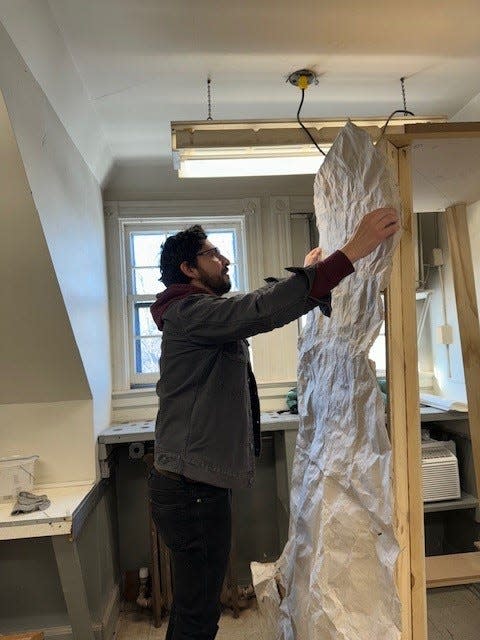
Lopez has studied the history of symbols of power like Columbus in Colombia, in Germany, in Boston and now in Utica. In his work, he is interested in the controversies and conversations around these symbols; he wants to inspire discourse around them rather than destroying them.
To that end, Lopez creates para-monuments or counter-monuments, a concept he learned about in Germany, a nation which has grappled with its own painful history post-World War II. Lopez’s counter-monuments are made of the fragile medium of handmade hemp paper in contrast to the solid materials that artists usually use to build statues.
“I want to see history in that way, without just saying that the idea of colonialism is going to be something that we can address only by destruction, because there’s tons of people in Colombia that will be opposed to the idea of the destruction of monuments,” Lopez said.
“And there's a lot of people in the art field that will also say, ‘We have to see the artistic value of this,’ because regardless of the person, this is a good example of craftsmanship. So considering all these ideas of how we can address the meaning of those symbols of power. The counter-monument is something that you can create in opposition to the actual monument to talk about that critically.”
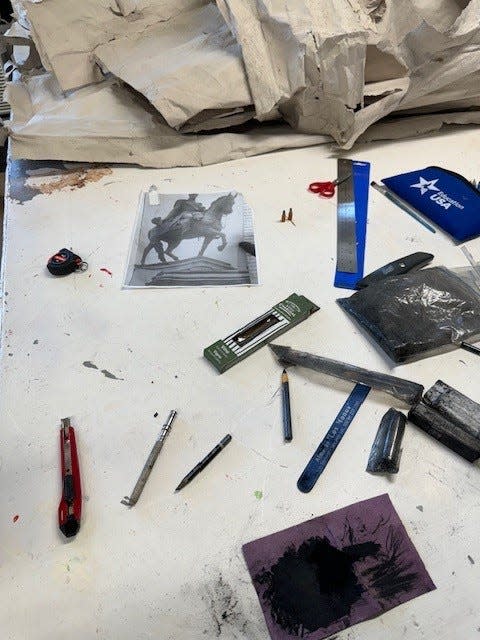
Belonging, history, nation
Lopez will mount a solo exhibition as part of the artist-in-residence program, which will be on view in the Pratt Munson Gallery located in Munson’s Fountain Elms building from March 1 to March 28. The exhibit will begin with an opening reception from 3 to 5 p.m. on Friday, which is free and open to the public.
As part of his work, with its attention to history, Lopez pulled materials from Munson’s archives. Audrey Taylor, director of the artist-in-residence program, explained why the program’s committee selected Lopez.
“I think what we saw there is, obviously the skill level is very high, so that was not in question,” Taylor said. “But it was also his interest in working with archives and working with the museum.”
Lopez’s studio is up two narrow, winding staircases in the Pratt Munson ceramics building. On a brisk day in mid-February, a work-in-progress charcoal drawing took up most of one wall in the studio. It featured mighty figures and symbols of power in Latin American history like Simón Bolívar alongside a representation of a painting by George Caleb Bingham called "The County Election."
The sketch will be finished in time to feature in Lopez’s exhibit. Lopez found his reference images for this sketch in both the archives of the Colombian National Library and in Munson’s collection of 19th century American art.
“I'm mixing those images to create that narrative of, what are those things that build the nation?” Lopez said. “Democracy, war, the idea of a hero, the idea of being proud of your flag, all those things, and I’m just repeating those elements.”
Lopez perched on a paint-splattered stool beside a large table scattered with his materials – charcoal pencils, a miniature tape measure, the reference photo of Simón Bolívar on horseback, a pile of homemade hemp paper. He spoke both energetically and contemplatively about the thought process that led him to his current artistic interests and practice.
“It's like an exploration of the medium that depends a little bit on the meaning of what I'm doing,” Lopez said. “Sometimes I have an idea of a subject, and that subject, I cannot talk about that in drawing, so I’m going for something else. If something, I think, fits into drawing, I do it with drawing. If it fits into the idea of paper-making, I try to do it with paper-making.”
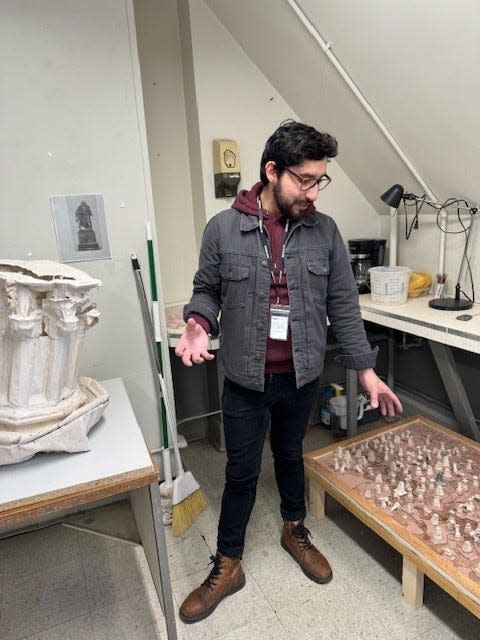
Lopez started thinking about the sense of belonging and place when he moved to Boston from Colombia three years ago to pursue an M.F.A. at Tufts University. He pondered things that made him feel connected to his national identity when he was away from home: salsa dancing, the flag, the national anthem, Simón Bolívar. He thought about the monuments to Columbus and to Spanish conquistadors in Colombia, and the fact that his country is named after Columbus.
“All those symbols that create a greater idea of society are the ones that are connected with hope,” Lopez said. “Who invented the national anthem? Who decided on the national flag? And with those, we start to think about who decided to set monuments here, and why."
"So I started to see how the society that we have in Colombia was built based on the actions of the past. That comes to the idea of who decided those actions? Politicians. In what sense? Laws, things like that. And who decided to come up with the idea of having a monument to Christopher Columbus in Bogotá? And who decided to have a monument to Simón Bolívar after the independence, or things like that? So all those ideas build the idea of ‘nation,’ and then all those ideas also are related with power.”
Casting the monument
Lopez used his hemp paper, which will ultimately hang on a wooden structure that almost reaches the ceiling of the studio, to make castings of both sculptures in Munson’s collection and of the Columbus monument on Memorial Parkway.
Lopez said when he and a group of Pratt Munson students made casts of the monument, they encountered some resistance from the community. He said the police were called a couple of times and that some residents swore at him, but that he did that work with the support of Pratt Munson and of the mayor.
Lopez understands that figures like Columbus are contested and mean different things to different people, like the Italian-American community and indigenous communities. He chose to leave only part of the inscription from the monument for his paper counter-monument: the paper cast reads, “The great Italian navigator died in humiliation and misery.”
“I know that there are some people that can be annoyed or mad by having images that are destroying their monuments, but I also want to see what is the reaction of people when they have that conversation with all those images,” Lopez said. “I’m really excited about that, and I'm really excited about seeing all the works together.”
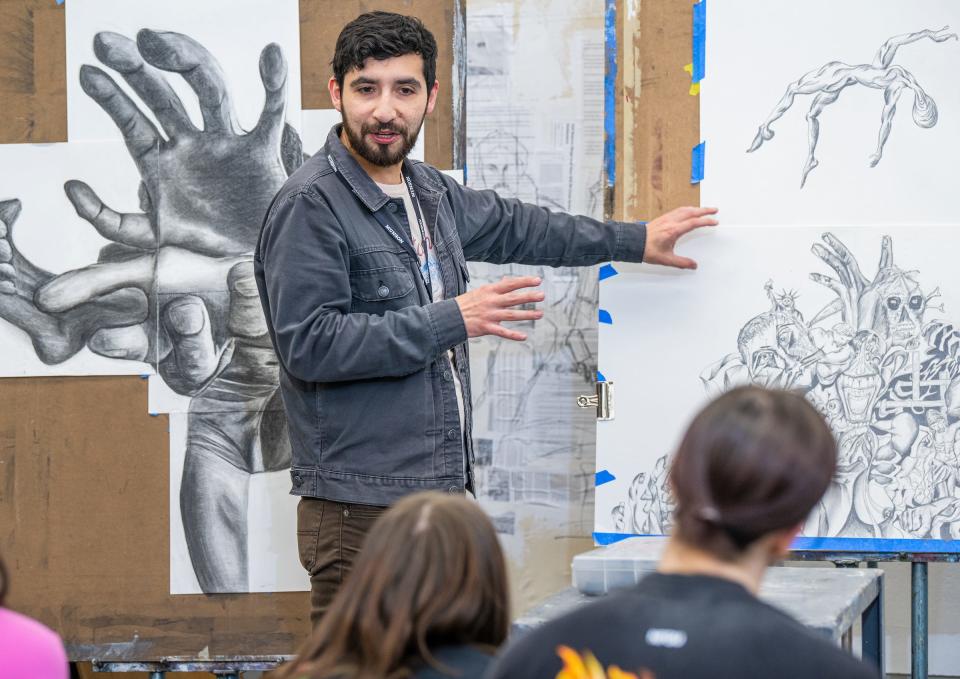
Student and teacher
Lopez began his arts education with classical training in painting and drawing at the National University of Colombia, and earned a master’s of arts education at the same school. He spent some time teaching in Colombia, but he wanted to pursue a master’s in fine arts in the United States, saying that such programs are scarce in his home country.
Lopez earned his M.F.A. in 2023, and said he appreciates the support and resources he has received from both Tufts and Pratt Munson. As part of his Tufts education, Lopez was able to travel to Germany and back to Colombia to study art and history.
“The difference is that we don't get the resources and the support that schools in the U.S. have,” Lopez said. “So that opened my mind and my work to endless possibilities, because things that I didn't dream to do in Colombia, I was able to do them here.”
Pratt Munson’s artist-in-residence program involves teaching as well as a strong studio practice. Artists stay for a full academic year, from August to May, and teach courses to Pratt Munson students as well as non-credit community art classes for all ages.
“It's specifically geared toward artists who are recently out of, perhaps, getting their master’s, or a couple years out,” Taylor said of the program. “And it’s kind of a nice nine-month landing place to both get some teaching experience and work on their art before they kind of move along, and apply for full-time jobs, and things like that.”
For his community classes, Lopez has been teaching a portrait course and will teach a papermaking workshop in March. Lopez has been teaching classes in visual representation, which he calls the lexicon of drawing, and life study, or the human figure, to Pratt Munson students.
“It's mostly drawing, which I enjoy a lot, because drawing is my main medium,” Lopez said. “So that gives me the chance of also learning a little bit more about drawing in my own practice, because nothing teaches you more than learning how to say something again and present it to other people.”
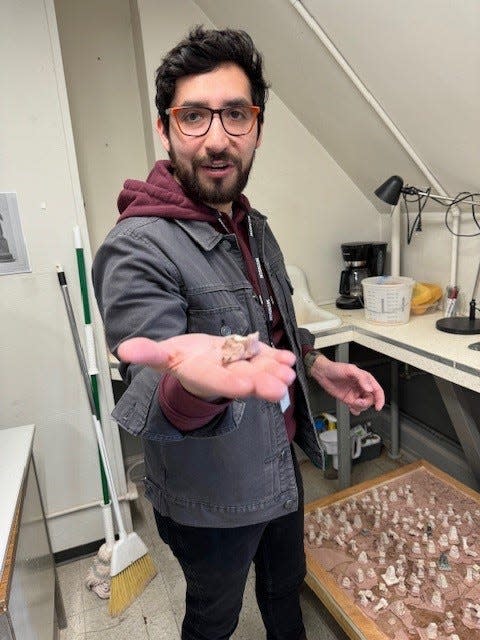
'Dedicated to memory'
Lopez displayed two components that make up a piece he worked on in his M.F.A. program, called “Consagrado a la memoria” or "Dedicated to memory."
The work, which will feature in his solo exhibition, particularly highlights the concept of the counter-monument.
The piece includes a wooden platform covered in miniature pedestals, mostly made of paper, but a few made of metal. Lopez said that he will pour red slip clay onto the platform to “activate” it, with the clay soaking into the paper pieces and causing them to lean and buckle. The position of those pedestals is inspired by a 19th-century topographic map of Bogotá that Lopez found in the Colombian National Library archives.
Another component of “Consagrado a la memoria” is a larger paper pedestal. A bit crumpled, it lists to one side.
“This started as a fully straight pedestal – it was standing up completely straight – and after a year, it’s decaying by itself,” Lopez said. “So for me, paper-making is really good, because with paper, I’m just trying to do things that I couldn't do with other mediums. So the concept behind this is that when you see this pedestal of paper, what they are doing is they’re kind of being taken down by themselves, not by an action. It’s just time doing it.”
With his counter-monument practice, Lopez hopes to interrogate the stereotypical narratives people learn about historical figures like Columbus. His paper versions of statues show that power is not fixed or absolute.
“These figures started to become such powerful symbols of something that we weren’t – like, because of them, you are civilized people,” Lopez said. “Because of them, you can talk language. Because of them, you are something. Which is not true. And for me, it started just to become a symbol of something that has to be imposed, and a symbol that is not possible to question."
"It was like, he’s the greatest hero. That’s it. But if something happened in consequence of this guy, that doesn’t mean we cannot question that. So I think that that is how I wanted to say it – sure, there are a lot of things that happened after this that built our society, but that doesn't mean that I don't want to question this guy. So in the first place, he’s not a hero. In the second place, I need to question what was talked about.”
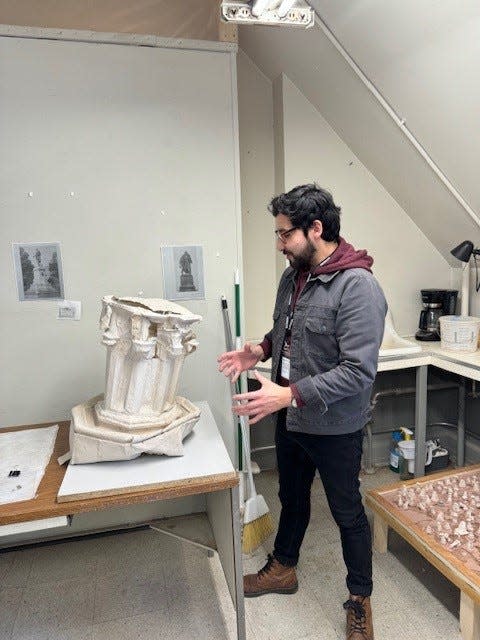
Learning in Utica, considering what's next
The artist-in-residence program has occurred every year since 2016 and is supported by the trust of Sunithi Bajekal, a Utica-based artist and passionate activist who passed away in 2014.
Taylor said that having artists like Lopez come to town is wonderful for everyone involved.
“It's been a really rewarding position to have new emerging artists on our campus each year,” she said. “It's energizing, and the artists and the students get a lot out of it.”
Lopez doesn’t know where he’ll go next after the residency ends in May. As an immigrant, his ability to stay in the United States hinges on whether or not he can get a visa to work, a precarious position which once again makes him think of belonging and not belonging.
In addition to this residency, Lopez still teaches at Tufts, and takes a 16-hour round trip by train to and from Boston every week. He would like to spend more time in Boston, which is a powerful site of American identity and nation-building, and continue his historical and archival practice wherever he is.
“There's so many places that can have a really interesting history that I can see,” Lopez said. “In Utica, it’s really nice, and as a professor it’s a really good place to stay. But, also as an artist, there's so many other conversations with history that I want to have.”
This article originally appeared on Observer-Dispatch: Pratt Munson Gallery exhibition by artist-in-residence Felipe Lopez

